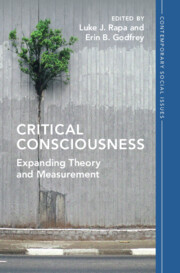Book contents
- Critical Consciousness
- Contemporary Social Issues
- Critical Consciousness
- Copyright page
- Dedication
- Contents
- Figures
- Tables
- Contributors
- Acknowledgments
- Introduction Critical Consciousness Theory and Measurement
- Part I Theory
- Part II Measurement
- 7 Critical Consciousness Measurement
- 8 Using Social Network Analysis to Identify Individual and Structural Precursors for Promoting Critical Consciousness in Childhood and Adolescence
- 9 Conceptualizing Adolescents’ Daily Critical Consciousness
- 10 Measurement and Analysis in Quantitative Critical Consciousness Research
- 11 The Development of the Contemporary Critical Consciousness Measure-Short
- Conclusion Expanding Critical Consciousness Theory and Measurement
- Index
- References
11 - The Development of the Contemporary Critical Consciousness Measure-Short
from Part II - Measurement
Published online by Cambridge University Press: 20 April 2023
- Critical Consciousness
- Contemporary Social Issues
- Critical Consciousness
- Copyright page
- Dedication
- Contents
- Figures
- Tables
- Contributors
- Acknowledgments
- Introduction Critical Consciousness Theory and Measurement
- Part I Theory
- Part II Measurement
- 7 Critical Consciousness Measurement
- 8 Using Social Network Analysis to Identify Individual and Structural Precursors for Promoting Critical Consciousness in Childhood and Adolescence
- 9 Conceptualizing Adolescents’ Daily Critical Consciousness
- 10 Measurement and Analysis in Quantitative Critical Consciousness Research
- 11 The Development of the Contemporary Critical Consciousness Measure-Short
- Conclusion Expanding Critical Consciousness Theory and Measurement
- Index
- References
Summary
The purpose of this project was to develop a brief, integrated measure that combines two previously published critical consciousness (CC) measures; the Contemporary Critical Consciousness Measure (CCCM (Shin et al., 2016) and CCCMII (Shin et al., 2018). This new measure is intended to assess awareness and attitudes related to various systemic, institutionalized forms of discrimination. Data from 475 participants provided initial reliability evidence for the Contemporary Critical Consciousness Measure-S (CCCM-S). Results from exploratory factor analyses suggest that the final 24-item CCCM-S provides a general index of CC as well as assesses CC specifically associated with racism, classism, heterosexism, ableism, and sexism/cis-sexism. Results support the internal consistency and factor structure of the measure. Future directions for research, training, and counseling implications are discussed.
- Type
- Chapter
- Information
- Critical ConsciousnessExpanding Theory and Measurement, pp. 287 - 308Publisher: Cambridge University PressPrint publication year: 2023



